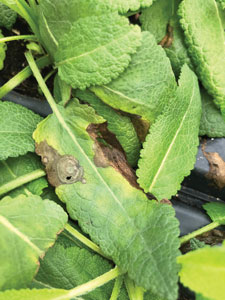4/1/2018
Show Me Your ID
Paul Pilon
I’m not asking to see your driver’s license to laugh at the outdated photo you’re likely not proud of, to see if you’re old enough to engage in an adult beverage or to confirm how many times you’ve celebrated your 25th birthday. Rather, I’m asking to see the diagnostic results from the last time you experienced a major cultural issue. You did get that diagnosed, didn’t you?
Even experienced pros and growers will likely encounter new cultural issues—or should I say “challenges”—from time to time. There’s no shame in admitting you don’t know what’s going on; however, there’s great shame in letting problems go on because you didn’t seek help or submit a sample for diagnosis. How many losses occurred or how were sales negatively affected the last time you had an “unknown” issue?

Why get it diagnosed?
Properly identifying plant disorders is an important aspect of growing perennials. In many cases, you’ve likely experienced a particular or similar issue in the past and already know how to manage the situation. Unfortunately, problem solving isn’t always that simple.
If an abnormality does exist, it’s important to try to identify its cause. It could be due to environmental responses, nutritional disorders or caused by plant pathogens or insect feeding, to name a few. Without the correct identification, a grower may implement a control strategy that’s ineffective and perhaps even costly.
If you find yourself at these crossroads when you’re not absolutely certain as to what’s hampering your plants and seemingly have used your lifelines (like calling a friend or coming up empty with your online search), consider submitting a sample to a diagnostic clinic for diagnosis.
When troubles arise, diagnostic clinics can and should be utilized to properly identify insects, plant pathogens, viruses and abiotic disorders. They also can be utilized to help determine the nutrient concentrations within the growing media, plant tissues and water samples.
Pictured: Here’s an example of an undiagnosed leaf spot I observed on salvia. My instinct tells me it’s caused by a fungal pathogen and my best guess would by Myrothecium. Without being 100% certain, it would probably be best to submit a sample for confirmation or to properly identify what pathogen is attacking these plants. This will allow me to implement the most effective management strategy for the situation at hand.
Collecting samples for diagnostic clinics
The type of sample to submit varies by the nature of results (for example, nutritional status vs. plant pathogens) you’re looking to obtain. Regardless, it’s important to submit the proper sample to the appropriate diagnostic clinic to obtain the desired results. Believe me, submitting the wrong sample can and does make a difference between correctly identifying the cause of the problem and getting an “inconclusive” response.
The following are guidelines to use when submitting samples to diagnostic clinics:
1. Background information. Use the clinic’s submission form or at the very least include: The plant’s scientific name, cultivar, the growing conditions, any fertilizers and pesticides applied to the crop, and any relevant observations describing why you’re submitting the sample(s).
2. Sample type. Send samples (leaves, stems and/or roots) that are just beginning to develop symptoms. Consider submitting the entire plant in the container it’s grown in.
3. Avoid completely dead samples. Dead tissues often contain an abundance of saprophytic pathogens, making it difficult for a diagnostician to determine the original or primary cause of the injury.
4. Submit multiple samples. Include samples showing various degrees of symptoms—perhaps one just beginning to show signs of the problem and one with symptoms that are obvious and can clearly be seen. Make sure each sample sent is clearly labeled and identified.
5. Submitting leaf samples. Submit enough leaves to demonstrate the various ranges of disease symptoms, from early stages to older, more advanced damage. Place the leaves in a plastic bag containing a dry paper towel. Keep refrigerated until shipping.
6. Submitting stem samples. Cut the stem below the point of injury to include some of the healthy stem tissue. Place the stems wrapped in dry paper towel into a plastic bag. With stem-related problems, such as blights and potential vascular issues, it’s also beneficial to submit samples of the roots as well. Keep refrigerated until shipping.
7. Submitting root samples. Include enough soil to keep the roots moist during transit. Consider sending the entire container (growing mix and roots).
8. Send samples to diagnostic clinics early in the week. Due to the nature of our business, it’s recommended to send any samples overnight to the diagnostic clinic. It typically takes one to five days, sometimes longer, to obtain a proper diagnosis.
When providing good samples and background information, diagnostic clinics can generally identify most of the cultural problems growers experience. With the correct diagnosis, growers can more effectively manage ailing crops.
Be careful when interpreting any cultural recommendations given by a clinic; they specialize in diagnosing plant problems, not producing plants or managing cultural situations. Always use this information and formulate your own solutions to cultural problems based on what is practical, effective and economical. GT
Paul Pilon is a Perennial Production Consultant and editor-at-large of the Perennial Pulse e-newsletter. Feel free to contact him with article topics or to address your perennial production challenges. He can be reached at paul@perennialsolutions.com.